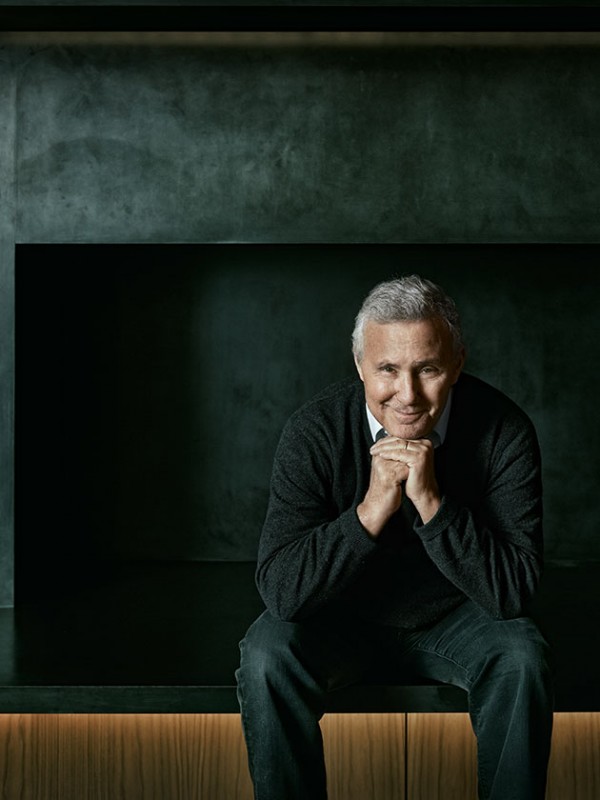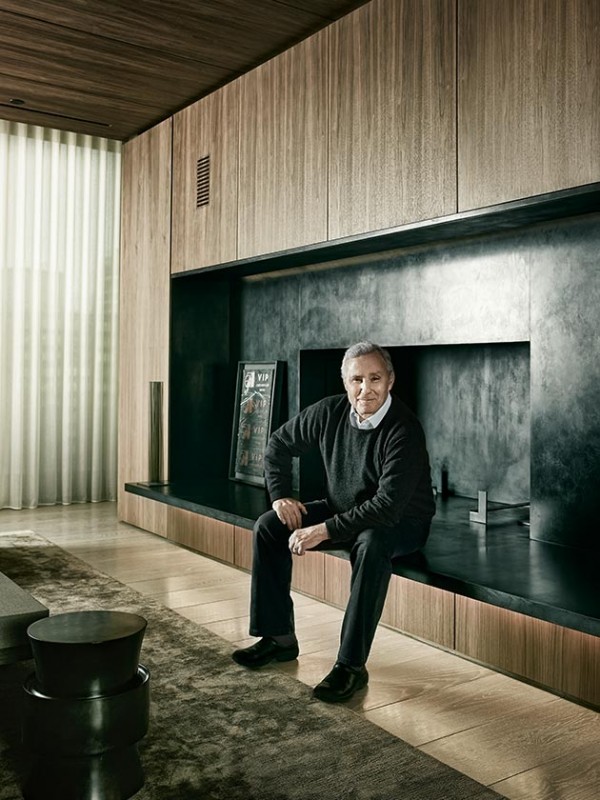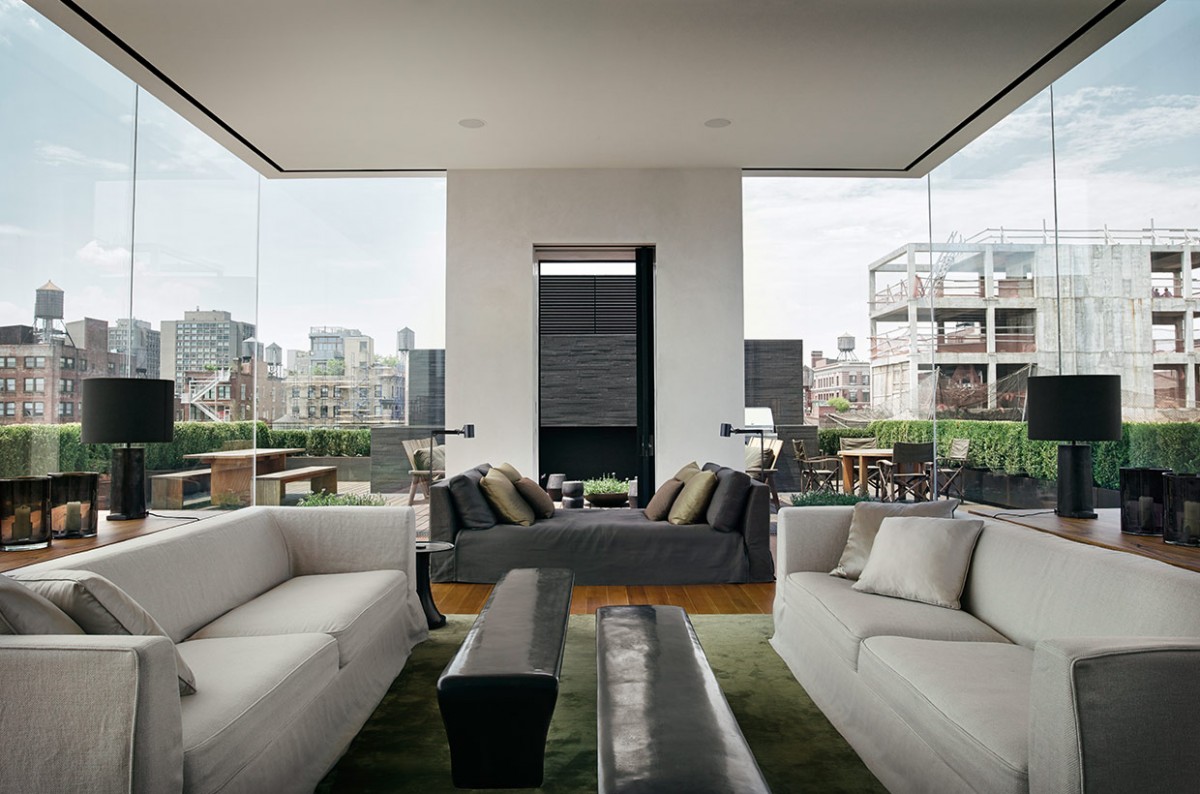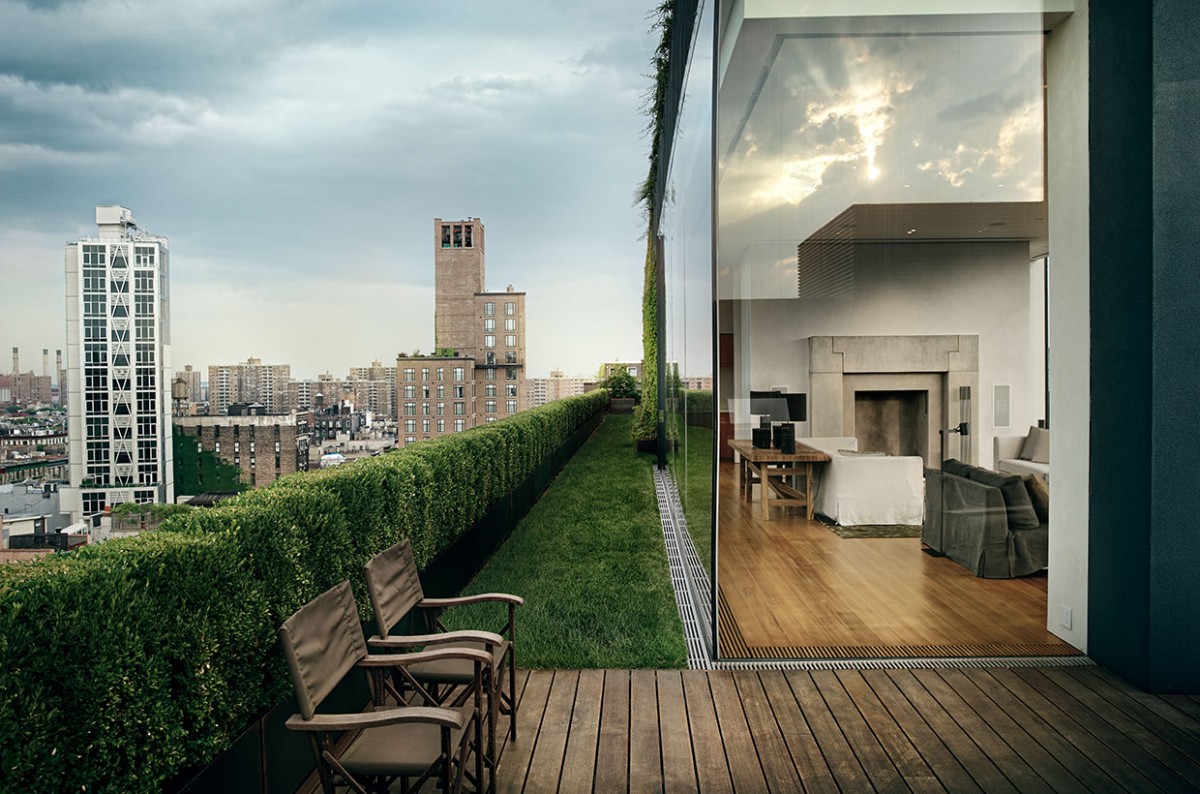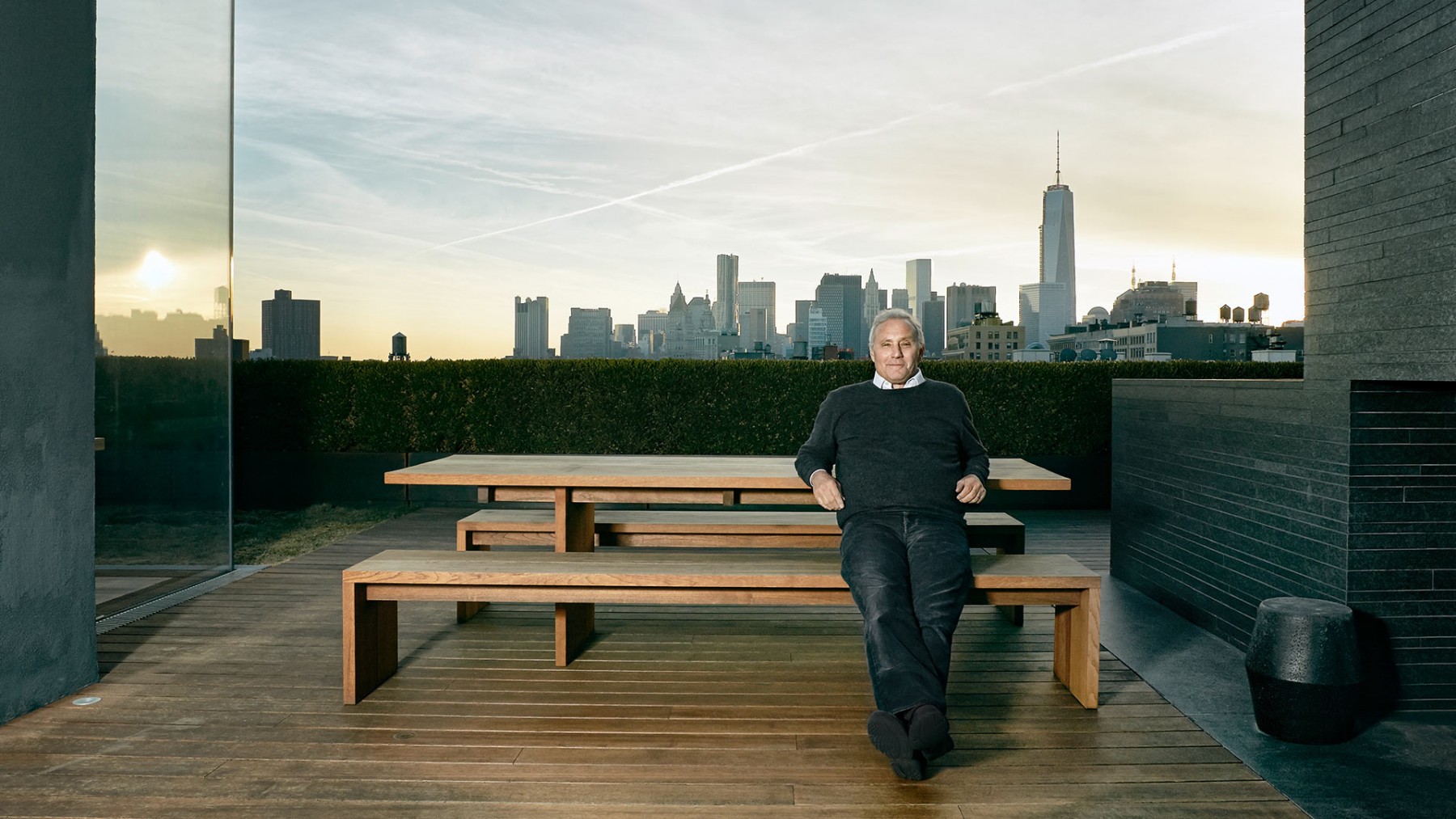Ian Schrager by Michaela Cordes | 20th August, 2014 | Personalities
In the 1970s, he partied with Andy Warhol and Bianca Jagger at his legendary nightclub Studio 54. In the ’90s, he created the chicest hotels with Andrée Putman and Philippe Starck. Now, Ian Schrager is back again. With his stunning new hotel The London Edition. GG met the iconic creator of unusual hospitality for a conversation about old times, new ideas and his life with five children.
At London’s new hotspot he sun rises in gleaming silver. An oval, high-gloss metal object created by lighting designer Ingo Maurer, suspended from the ceiling of the main lobby at The London Edition hotel. At an oversized black walnut table, reminiscent of the works of Donald Judd, a few hotel guests are working in front of their open laptops. Built in 1835, this former residence of King Edward VII, and later of Russian jeweler Carl Fabergé, is characterized by warm colors and a charming mix of well-preserved old and sophisticated new features. Welcome to the latest masterpiece by Ian Schrager, who throughout his career seems to have followed one rule only: Never stop thinking out of the box!
The native New Yorker achieved world-renowned status when he opened Studio 54, the famous nightclub created together with Steve Rubell. In a former TV studio, they threw legendary parties every night, cheered on by regular guests like Bianca Jagger, Andy Warhol, Calvin Klein and Diane von Furstenberg. Having spent 13 month in jail for tax evasion, Schrager later changed careers and entered the hospitality business. He founded his first hotels, which were captivating mainly because of their nightclub feel and designs and which were a lot more than just a bed for the night. He commissioned designers like Andrée Putman and Philippe Starck, hired staff that looked like beautiful models, and built the Morgans, the Royalton, the Paramount and the Mondrian hotels in Los Angeles, Miami and San Francisco. The term “boutique hotel” was born. When his business partner and best friend Rubell died of AIDS in 1989, he switched to the more high-end hotel business. Together with artist Julian Schnabel, he created the luxurious Gramercy Park Hotel in New York City, which grabbed headlines again – this time because of the stunning contemporary art Schrager put on display. And today? At the age of 67, Ian Schrager has surprised the industry once again: in 2009 he formed a partnership with the hotel chain Marriott. Two “Edition” hotels are planned for New York City, and another location is due to open in Miami this year. We are sitting in the calm, Zen-like atmosphere of the penthouse suite of his London hotel. Ian Schrager talks with a typical New York accent. He smiles a lot and seems to be very relaxed.
“I came from a provincial place and all of a sudden I was catering to the most famous designers in the world. It was incredible!” Ian Schrager
Your life sounds incredibly exciting. To what extent have the wild years at Studio 54 shaped you as an entrepreneur, and as a person? To create a nightclub requires know-how in more than one discipline, and I took on all of them: lighting, fashion, music, theatre and film. When I started out, I didn’t really know anything about any of these. I was a young man with no experience, and had to teach myself everything. It was an incredible education and an enormous break. I just took the opportunities that presented themselves. I came from a very provincial part of New York and had no idea about fashion. And all of a sudden, I was catering to the famous designers in the world. It was incredible!
Where are you from, exactly? I’m from Brooklyn. Back then I was a young lawyer, who was spoiled by success early on and got bored quickly. I had won a very important case, right at the beginning of my career. My success made me itch for something different. It was the 1970s, the time of the sexual revolution, and the time of the gay scene emerging as a kind of trend-setting cultural movement. All this was happening in New York City. It was a lawless time, and incredibly exciting. That’s when my friend Steve (Rubell) and I had the idea of going into the restaurant business. I still remember the opening night of our first club: Steve went to hang out at the bar and I stayed in the DJ booth and played around with the lights. That kind of set the tone for us working together. In order to survive we had to keep coming up with new sets and effects, and host themed parties. We grew with every project, and kept getting better and more professional. At the time, I didn’t know all the things that I was capable of…
Where did your passion for extraordinary parties come from? Were your parents great hosts? My father died when I was 19, and my mother four years after that, when I was 23. If they hadn’t died so early, I don’t think I would have ever gone into the nightclub business (laughs). My father had a coat-making business and my mother was a housewife. My brother became a doctor, I became a lawyer – and my parents were in heaven! That’s what they had always dreamed of (smiles). But yes, my parents were gracious hosts. They had great taste – modest, but very tasteful. My parents threw great parties, not very often, but when they did, they were a lot of fun. Yes, the memories of these parties definitely had an influence on me. It’s funny, you don’t realize these things at the time, but when you look back, you connect the dots.
“My parents were gracious hosts. It’s only when you look back that you connect the dots.“ Ian Schrager
What were your greatest challenges during your time at Studio 54? We signed the lease in January 1977, and only had six weeks until the opening. At the time there were very few people who knew about lighting and sound, and the best of those came from the theatre. So we hired them. I still believe that theatre people are the most talented and gifted people to work with. Unfortunately they are also the most expensive, because there is very little scope for making mistakes in that industry. We did a lot of really crazy things like flying in whole sets or changing the space completely. Guests want to be surprised!
That sounds as if the spectacular nights at Studio 54 cost more money than they made? Of course! (laughs) But that is something that I explain to my kids these days. The secret is turning a negative into a positive.
What happened after that – did you dream of opening a hotel even back then? It’s funny, it was kind of a logical progression. The nightclub business is essentially the most uncivilized part of the hospitality industry, the most cultured being the hotel business. At the time, there was a sort of war going on in New York City, which the press was stoking up – between Donald Trump, who was one of the new generation of hoteliers, and Harry Helmsley, who represented the old guard. I stood in the middle and thought: Boy, I should do that!
What you did then was completely “out of the box” – nobody had ever thought of creating anything like boutique hotels. To us, it felt quite natural. But for the guests it was something new. Because the hotel trade is so capital-intensive, it did not encourage new ideas. Everyone did what had been done before, just in a different color.
Were you tired of the nightlife business, maybe because you had seen it all? The nightclub business eats you up; it consumes you. You have to escape, get out and move on.
“The nightclub business consumes you, if you don’t get out at some point. Hotels were a logical progression for me.” Ian Schrager
What is so tiring about it? Is it the fact that you have to be there every night? Steve was there a lot more at night, and often really late. I always left when I saw everything was running smoothly. Steve stayed too long. I left too early. It’s a business that consumes you, if you’re not careful. It is difficult to stay healthy, when everybody around you is drinking and having a great time, with loud music playing constantly.
At the same time, you as the host have to be the life and soul of the party. So did you decide one day “That’s it. I have to get out to stay alive”? I didn’t have anything new to offer, I’d given all I had to give. If I’d had any new ideas, maybe I would have carried on. It’s funny – after all these years, I opened a club again for the first time, downstairs in the basement of this hotel.
Really? What is it called? The Basement. I had really wanted to call it “Crazy Box” but it’s now called “The Basement.” It’s a serious, no-nonsense dance club – not for socializing, like so many today – only for dancing! I once recreated Studio 54 for one night for a friend of mine, and took along my daughters. They are 19, 17, 16 and 15, and they loved it! That was when I thought maybe it’s time for real dance clubs again. That’s why I will open some in our hotels.
It sounds like you get bored easily, as soon as you find out that an idea is working. Do you then quickly have to find another challenge? Of course! When I started off, hotels were generic and very similar to each other. Everything was based on a mass-market model. People thought: OK – this works. Let’s roll the concept out from New York and take it to London, Paris and California. But that’s not how it works. I’m not interested in going to Paris only to eat at McDonald’s. I always try to create something innovative and provocative. That’s how I came to take over the Gramercy Park Hotel that was more or less bankrupt at the time. It was not my personal style, but we wanted to do something different. Maybe it was more of an intellectual effort.
But wasn’t it primarily about a visionary approach – about combining art and hotel life? For me it was not just about hanging art on the walls. It was really more about making it part of the scenery, making it accessible. So people can enjoy art without having to go to a museum, which in America is like going to a crowded subway station. At the Morgans, we had already put up 150 Robert Mapplethorpe prints on the walls. Another time, I asked Giorgio Armani to design the uniforms. But I stopped doing that when everybody started copying me. If you want to land a hit, you have to do something new and fresh.
Another provocative move in your career was stepping away from the Gramercy Park Hotel, and announcing that you were going to be opening a number of hotels with the Marriott group. I never get attached to my various projects. I love creating them, but I never take pictures when I am working on them, for example. Don’t forget, I have worked on 15 hotels, and often felt like everyone else came and pickpocketed my ideas. I am not one of those people who feel flattered when they are being copied.
How did the Mariott deal come together? I have always admired Bill Marriott and thought it would be fascinating to combine his systems-driven, superbly executed company and my ideas, and to start something really great together.
Do you still live in New York City? Yes, in my beautiful apartment with all my kids. One day I woke up and thought that I always invest all my energy into my work in these great hotels, never into my own place. Some of my friends already had really spectacular apartments back then, so I thought I needed to create a nice home, too. I managed to create a beautiful apartment, with some help from Christian Liaigre and John Pawson.
Do you collect art? I like Anish Kapoor, Andy Warhol, Julian Schnabel and all those artists from the ’80s. I also have a couple of Picasso drawings. But I am not one of those captains of industry who collects art just to show off their success. If I see something I love, I buy it.
Do you primarily collect artists that you know personally? Yes, exactly. Some of them even gave me pieces of art as presents. Andy Warhol, for example, used to come to Studio 54 and give me things all the time. Thank God, I saved them… (laughs).
It must be funny for you, looking back at all your regulars who proceeded to become icons? I don’t actually think of them as icons, because I saw all of their vulnerabilities and their humanity. But it makes me smile sometimes, for example when one of my friends, a well-known New York collector, said that Andy Warhol was one of the most important artists of the last 500 years. That puts him right up there with Michelangelo. Well, maybe he was. I will just always remember the man who was walking around Studio 54 at three in the morning.
You are a father to four daughters and a 3-year-old son. What is Ian Schrager like as a father? We all get along great. My daughters are now of an age where they are dating, and when they go out at night, and give me a kiss goodbye, I usually send them back to their rooms to get changed, because what they are wearing is just too extreme – too tight, too short or too low-cut for my taste (laughs). mc
